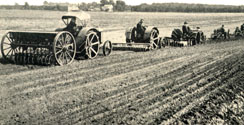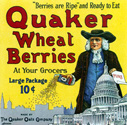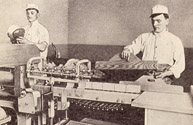


Baking Day in Blanksville, Ohio, 1832. You take the fire out of the bake-oven, throw some flour onto the oven floor, and close the door. When you open it moments later, the flour has burned. You'll have to let the oven cool a bit before you put the bread in so you go out the side door - it's getting cold! - out to the cellar to get some apples. You feel like making a pie today. For dinner, you'll have the pot you started this morning, hanging from the iron hook in the hearth. It's something your mother made, salt pork and thyme from the kitchen garden, with vegetable scraps from yesterday's stew. You'll wait for M. to get home and lift the pot from the hook; it's heavy enough when it's empty! From the pantry you fetch the flour; from the dairy room, some of yesterday's butter. The bread! Now the oven'll be too cold! It's O.K. The bread's in. You've still time to roll the pastry before dinner. You pull a pie plate out of the step-back; M.'s mother gave it to you. That reminds you: M.'s brother just bought his wife a small cookstove. You haven't seen it yet but you don't think much of those new things, preferring the cooking hearth that you know. Besides, you've heard that it's so hard to get the temperature right! Back to the table, cut the butter, sift the flour. You sit down to peel the apples. Your shoulders are tired from kneading the dough, not to mention the butter yesterday. Then M. bursts in the side door: "Bad news, Mrs: The milch cow is dead."
Tuesday Morning, 1899. You've served the children Oats for breakfast because they are best for their development; poor M. barely had time for his ham and eggs and coffee before he had to rush down to the Bank! Now you bustle to get everything back in its proper place before its time to go to the market. But Oh! The coal dust, always the coal dust! You'll have to clean the stove again before you can wash the linoleum. You make a shopping list for the next 2 days; you've copied a menu from the Ladies' Home Journal so you know exactly what you will need and what it will cost. You've a busy day ahead; planning helps. After luncheon - Fritters of Canned Corn to go with the beefsteaks, bread and butter and cake - you've got to get ready for Tea. At 4:00, the Harland sisters are coming over with their great-aunt visiting from Des Moines. She may not like the Lobster Sandwiches you're going to serve so you'd better get some extra Tea Cookies: the best on the market will have to do. The milk's been delivered, check, the ice, check, check. The corn and the lobster are in the pantry. You just need to pick up the bread and the cookies. And one more thing: Stove Cleaner.
In the beginning of the century, for the most part, people produced what they ate, ate what they produced, and lived near the sources of production for the items in their pantries, smokehouses, or root cellars. Capitalism existed as a type of local mercantilism; if you needed something you couldn't produce, you had the general store (where you could buy on credit) or you might make an exchange with a neighbor. By the close of the century, however, industrialization had put its own system of commerce into being, a system that took food production (and the production of soap, candles, furniture...) out of the home (and/or local, artisanal economy) and placed it in the factory. An increasingly far reaching system of rail distribution made this abundance of goods widely available to the system's new citizen prototype, the consumer. All that was left to do was convince that consumer which product to buy.
In the end industrialization changed not only the landscape, but the course and the pace of life itself. This change of pace, of purpose, and of place is here presented in terms of the kitchen. The supposition is that the kitchen, an interior social and personal space was mediated into someone else's space: Nabisco's space, Postum's place, any number of corporation's space, and that advertising indeed created a new kitchen, a kitchen for products and not for production. Production went to the new national food corporations who, with the help of new technologies, modern advertising, and a burgeoning urban and literate middle class, managed to make a mint in the American kitchen.


composed by sarah m. white december 2000
american studies at the university of virginia